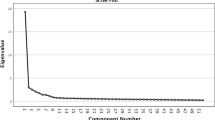Abstract
Psychometric properties of 24 items from the fifth grade Early Childhood Longitudinal Study-Kindergarten Cohort Mathematics Teacher Questionnaire were investigated in a sample of 5,181 participants. These items asked teachers to report how often they had their classroom students engage in different mathematics content, skills and instructional practices. Exploratory factor analyses were employed to evaluate the underlying factor structure of the selected items. Results suggest that these items effectively measure three distinct latent constructs that are specific to mathematics instruction: Instructional Practices for Teaching Mathematics, Developing Number Sense, and Beyond Number Sense. These results support the use of this instrument as a guide for research and policy, or to inform teacher curriculum decisions.
Similar content being viewed by others
References
Ball, D., & Rowan, B. (2004). Introduction: Measuring instruction. Elementary School Journal, 105, 3–10.
Cattell, R. B. (1966). The scree test for the number of factors. Multivariate Behavioral Research, 1, 245–276.
Cohen, D. K., & Hill, H. C. (2000). Instructional policy and classroom performance: The mathematics re-form in California. Teachers College Record, 102, 294–343.
DiStefano, C., Zhu, M., Mîndrilă, D. (2009). Understanding and using factor scores: Considerations for the applied researcher. Practical Assessment, Research & Evaluation, 14 (20). Available online: http://pareonline.net/getvn.asp?v=14&n=20.
Gehrke, N. J., Knapp, M. S., & Sirontnik, K. A. (1992). In search of the school curriculum. Review of Research in Education, 18, 51–110.
Ginsburg, A., Cooke, G., Leinwand, S., Noell, J., Pollock, E. (2005). Reassessing U.S. international mathematics performance: New findings from the 2003 TIMSS and PISA. Washington, DC: American Institutes for Research.
Hiebert, J. (1999). Relationships between research and the NCTM standards. Journal for Research in Mathematics Education, 30, 3–19.
Hiebert, J., & Grouws, D. (2007). The effects of classroom mathematics teaching on students’ learning. In F. K. Lester (Ed.), Second handbook of research on mathematics teaching and learning (pp. 371–404). Greenwich, CT: Information Age.
Hiebert, J., & Stigler, J. W. (2004). Improving mathematics teaching. Educational Leadership, 61(5), 12–17.
Hill, H. (2001). Policy is not enough: Interpretation of state standards. American Educational Research Journal, 28, 289–318.
Horn, J. L. (1965). A rationale and test for the number of factors in factor analysis. Psychometrika, 30, 179–185.
Kaiser, H. F. (1958). The application of electronic computers to factor analysis. Educational and Psychological Measurement, 20, 141–151.
Kilpatrick, J., Swafford, J., Findell, B. (2001). Adding it up: Helping children learn mathematics (National Research Council. Mathematics Learning Study Committee). Washington, DC: National Academy Press.
Ledesma, R. D., & Valero-Mora, P. (2007). Determining the number of factors to retain in EFA: An easy-to-use computer program for carrying out parallel analysis. Practical Assessment, Research and Evaluation, 12, 1–11.
Lubienski, S. T. (2006). Examining instruction, achievement and equity with NAEP mathematics data. Education Policy Analysis Archives, 14(14). Retrieved December 2 from http://epaa.asu.edu/epaa/v14n14/.
Mayer, D. P. (1999). Measuring instructional practice: Can policymakers trust survey data? Educational Evaluation and Policy Analysis, 21, 29–45.
National Council of Teachers of Mathematics. (2000). Principles and standards for school mathematics (3rd ed.). Reston, VA: NCTM.
Tourangeau, K., Nord, C., Lê, T., Pollack, J. M., & Atkins-Burnett, S. (2006). Early Childhood Longitudinal Study, Kindergarten class of 1998–99 (ECLS-K), combined user’s manual for the ECLS-K fifth-grade data files and electronic codebooks (NCES 2006–032). U.S. Department of Education, Washington, DC: National Center for Education Statistics.
Nye, B., Konstantopolous, S., & Hedges, L. (2004). How large are teacher effects? Educational Evaluation and Policy, 26, 237–257.
O’Connor, B. P. (2000). SPSS and SAS programs for determining the number of components using parallel analysis and Velicer’s MAP test. Behavior Research Methods, Instruments & Computers, 32, 396–402.
Palmer, P. J. (1998). The courage to teach. San Francisco: Jossey-Bass.
Porter, A. (1989). A curriculum out of balance: The case of elementary school mathematics. Educational Researcher, 18(5), 9–15.
Porter, A. C. (2002). Measuring the content of instruction: Uses in research and practice. Educational Researcher, 31(7), 3–14.
Porter, A. C., Chester, M. D., & Schlesinger, M. D. (2004). Framework for an effective assessment and accountability program: The philadelphia example. Teachers College Record, 106(6), 1358–1400.
Princiotta, D., Flanagan, K.D., Germino-Hausken, E. (2006). Fifth grade: Findings from the fifth-grade follow-up of the Early Childhood Longitudinal Study, Kindergarten class of 1998–99 (ECLS-K) (NCES 2006-038).
Rowan, B., Correnti, R., & Miller, R. (2002). What large-scale, survey research tells us about teacher effects on student achievement: Insight from the prospectus study of elementary schools. Teachers College Record, 104, 1535–1567.
Schmidt, W., Huoang, R., & Cogan, L. (2002). A coherent curriculum: The case of mathematics. American Educator, 26(2), 1–7.
Stein, M., Remillard, J., & Smith, M. (2007). How curriculum influences student learning. In D. A. Grouws (Ed.), Handbook of research on mathematics teaching and learning (pp. 319–367). National Council of Teachers of Mathematics: Macmillan.
Thompson, B. (2004). Exploratory and confirmatory factor analysis: Understanding concepts and applications. Washington, DC: American Psychological Association.
U.S. Department of Education. (2008). The final report of the National Mathematics Advisory Panel. Washington, DC: National Center for Education Statistics. Retrieved January 10, 2009 from http://www.ed.gov/about/bdscomm/list/mathpanel/report/final-report.pdf.
Wenglinsky, H. (2004). Closing the racial achievement gap: The role of reforming instructional practices. Education Policy Analysis Archives, 12(64). Retrieved December 2, 2009 from http://epaa.asu.edu/epaa/v12n64/.
Acknowledgments
The research reported here was supported by the Institute of Education Sciences, US Department of Education, through Grant R305B040049 to the University of Virginia. The opinions expressed are those of the authors and do not represent views of the US Department of Education.
Author information
Authors and Affiliations
Corresponding author
Rights and permissions
About this article
Cite this article
Ottmar, E.R., Konold, T.R., Berry, R.Q. et al. Evaluating the structure of the Mathematics Teacher Questionnaire: A measure of exposure to mathematics instructional practices and content. Learning Environ Res 17, 127–138 (2014). https://doi.org/10.1007/s10984-013-9147-5
Received:
Accepted:
Published:
Issue Date:
DOI: https://doi.org/10.1007/s10984-013-9147-5




